E-Rupee, a digital version of India’s national currency Rupee, was announced in November 2022. The CBDC (Central Bank Digital Currency) is managed by the country’s top financial regulator, the Reserve Bank of India. As of July 2023, e-rupee is in the pilot test, and one needs an invite from their bank to participate.
In this article, we will guide you on how to get started with the e-Rupee. Please keep reading to learn more.
How Do You Get Started With e-Rupee?
Step 1: Get an Invite
As mentioned above, you need a bank invite to access the e-Rupee at the moment. The Reserve Bank of India has partnered with several financial institutions, including ICICI Bank, State Bank of India, IDFC First Bank, and Yes Bank, to facilitate the pilot program.
So can you apply for access to the CBDC? No! Unfortunately, you have to wait for your bank to invite you. When your name is picked, the bank sends you an email or an SMS requesting you to take part in e-Rupee’s pilot program. That said, Indians are advised to keep an eye on their phone notifications and inboxes.
Step 2: Download and Install the e-Rupee App
After securing an invite, you are supposed to download the e-Rupee app, which is available on both Apple’s App Store and Google’s Play Store. Just search “Digital Rupee App” on any of the two stores.
Step 3: Register
Immediately you open the CBDC app, it will request you to approve some permissions, including access to your text messages and contacts. Note that you cannot proceed further without granting these permissions. After doing so, the next step involves agreeing to the terms and conditions.
Now, it is registration time. You will start by confirming the SIM card connected to your bank account. After that, create a PIN for accessing your app. The PIN will let you use the app without the need for an OTP (one-time password).
There is also another PIN that needs to be set. This one is for accessing your wallet. The wallet PIN should be different from the one set for the app. Now link the e-Rupee app to your bank account.
Finally, you need to complete the KYC (Know-Your-Customer) verification process by providing the expiry date and the last six digits of your debit card. And that’s it; you can now access the digital Rupee.
How to Use e-Rupee
With e-Rupee, you can use it to make person-to-person and person-to-merchant transactions. Therefore, it is possible to pay for services and goods at all retail outlets supporting e-Rupee payments.
It is important to mention that all e-Rupee tokens have unique serial numbers used to track their movements on the blockchain. This helps the Indian government to curb money laundering and other illegal activities.
How to Own e-Rupee
It’s time to discuss how you can fund your e-Rupee wallet. The process is simple. Since the wallet is already linked to your bank account, you can easily transfer funds from the bank, and they are automatically converted into digital Rupees once they arrive on the app.
How to Send and Receive e-Rupee
E-Rupee transactions function just like normal e-wallet transactions. For instance, you if want to send, let’s say, 800 e-Rupees to a relative, you can transfer four 200 digital Rupee tokens. This is because there is no e-Rupee note denominated with 800.
Can You Convert the e-Rupee to Cash?
Yes! It is possible to convert your digital Rupees to cash, and you can do this by visiting the bank that invited you to participate in the pilot program. Another easy way to cash out your e-Rupee tokens is by transferring them to your linked bank account and then making a normal withdrawal.
Conclusion
Despite the e-Rupee being in the pilot test, it has already proven useful as it facilitates faster transactions than the traditional finance system. In addition, the CBDC has enabled the Indian government to track all transactions, making it easy to block suspicious ones.
